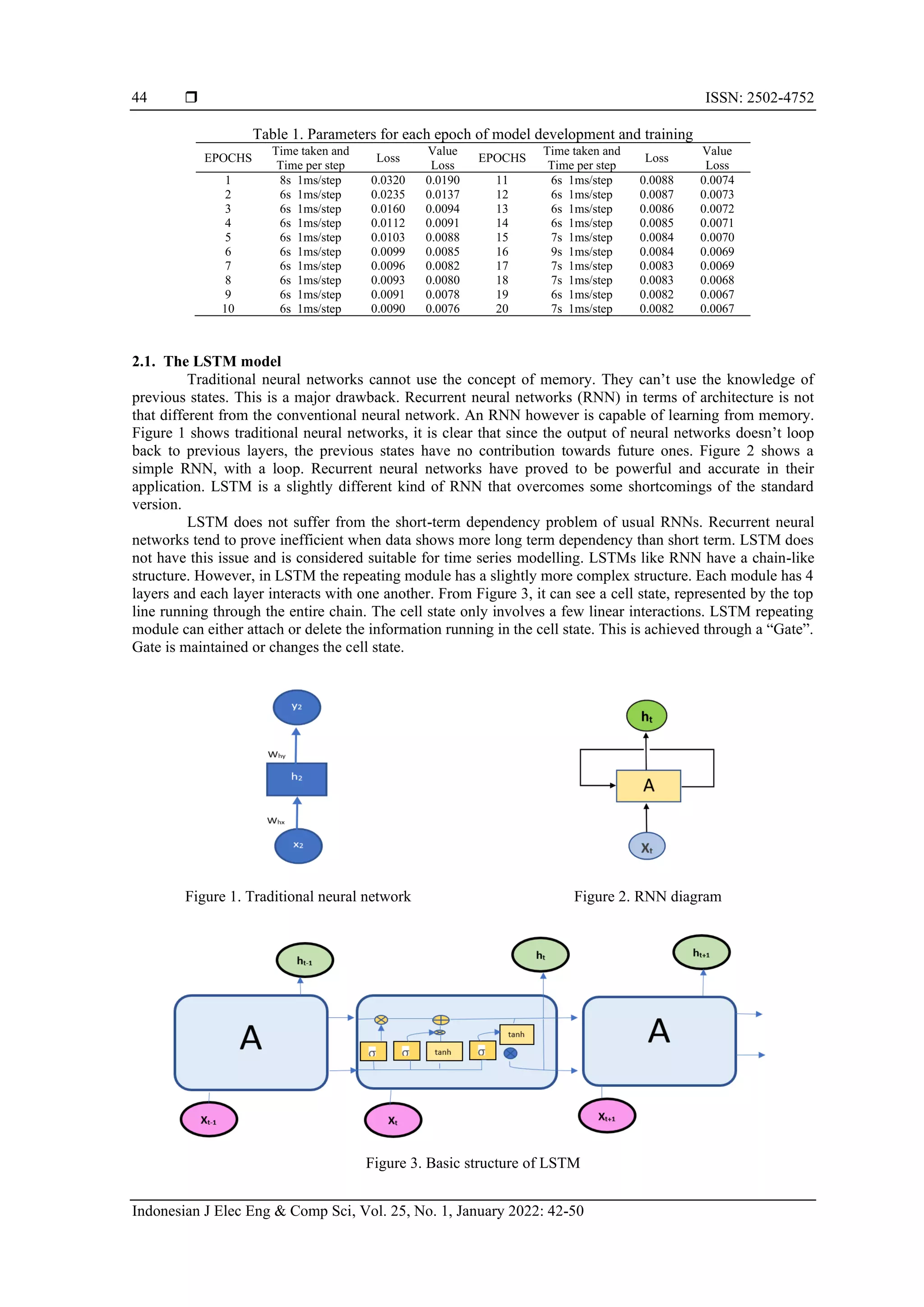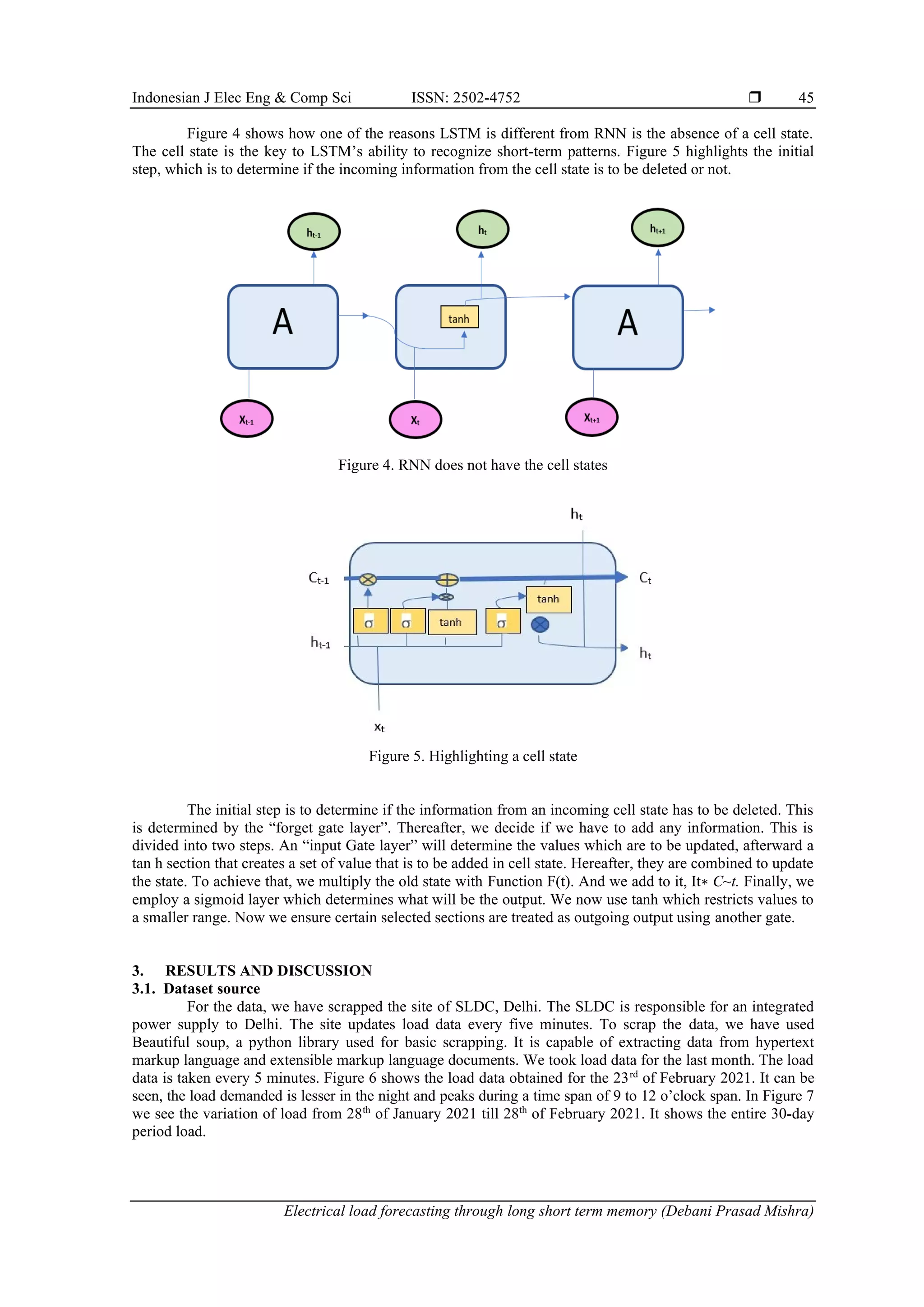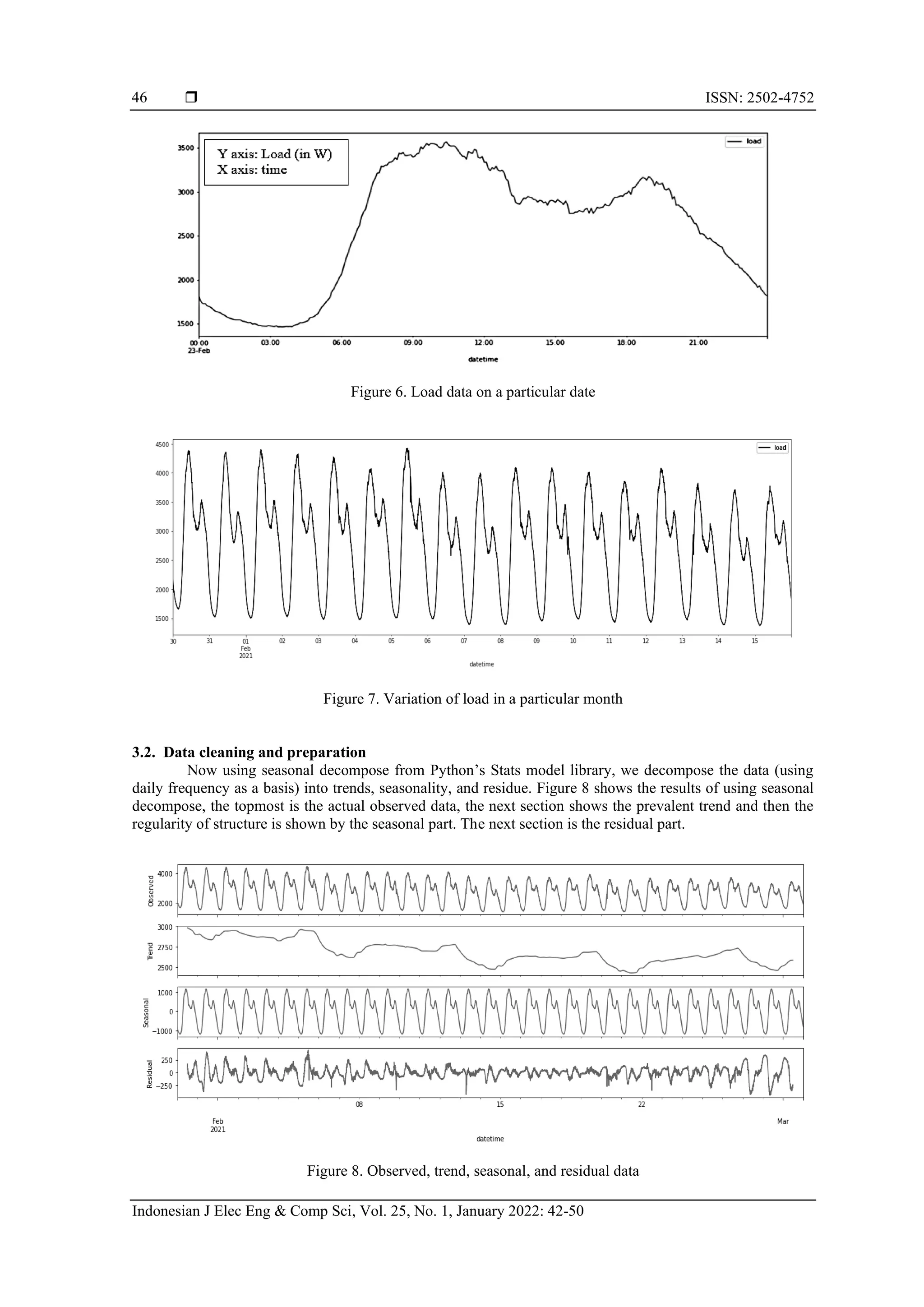The paper explores the use of Long Short-Term Memory (LSTM) neural networks for electrical load forecasting, emphasizing the importance of accurate predictions in maintaining demand-supply balance in power systems. It discusses the inherent complexities influenced by various short-term and long-term factors, particularly focusing on climate impacts. Results indicate that LSTM models demonstrate high accuracy in forecasting future electrical demands for a major dispatch center in Delhi.
![Indonesian Journal of Electrical Engineering and Computer Science
Vol. 25, No. 1, January 2022, pp. 42~50
ISSN: 2502-4752, DOI: 10.11591/ijeecs.v25.i1.pp42-50 42
Journal homepage: http://ijeecs.iaescore.com
Electrical load forecasting through long short term memory
Debani Prasad Mishra1
, Sanhita Mishra2
, Rakesh Kumar Yadav1
, Rishabh Vishnoi1
,
Surender Reddy Salkuti3
1
Department of Electrical Engineering, IIIT Bhubaneswar, Bhubaneswar, India
2
Department of Electrical Engineering, KIIT Deemed to be University, Odisha, India
3
Department of Railroad and Electrical Engineering, Woosong University, Daejeon, Republic of Korea
Article Info ABSTRACT
Article history:
Received May 20, 2021
Revised Nov 6, 2021
Accepted Nov 27, 2021
For a power supplier, meeting demand-supply equilibrium is of utmost
importance. Electrical energy must be generated according to demand, as a
large amount of electrical energy cannot be stored. For the proper
functioning of a power supply system, an adequate model for predicting load
is a necessity. In the present world, in almost every industry, whether it be
healthcare, agriculture, and consulting, growing digitization and automation
is a prominent feature. As a result, large sets of data related to these
industries are being generated, which when subjected to rigorous analysis,
yield out-of-the-box methods to optimize the business and services offered.
This paper aims to ascertain the viability of long short term memory (LSTM)
neural networks, a recurrent neural network capable of handling both long-
term and short-term dependencies of data sets, for predicting load that is to
be met by a Dispatch Center located in a major city. The result shows
appreciable accuracy in forecasting future demand.
Keywords:
Daily load curve
Factors affecting load
Long short term memory
Monthly load curve
Recurrent neural network
Root mean square deviation
This is an open access article under the CC BY-SA license.
Corresponding Author:
Surender Reddy Salkuti
Department of Railroad and Electrical Engineering, Woosong University
Jayang-Dong, Dong-Gu, Daejeon, Republic of Korea
Email: surender@wsu.ac.kr
1. INTRODUCTION
Electricity is an extremely important source of energy and plays a significant role in a country’s
economic development [1]. Load forecasting is necessary for the proper functioning of electrical dispatch
centers. Load forecasting is a method used to maintain synchronicity of demand and supply of electrical
power. With a greater contention for the market and greater decentralization, short-term forecasting is
becoming more significant [2]. In an age where smart grids with advanced sensing and communication are
fast becoming a reality, load forecasting is a field where the scope and necessity of accuracy are increasing
day by day [3]. Numerous significant decisions depend upon the load forecasts like economic dispatch,
distribution schedule, schedule of protection, and maintenance measures [4]. From proper maintenance of
equipment to the economic strategies of the suppliers, load forecasting has a significant impact [5].
Especially for small-scale consumption units, peak load forecasting is very important [6]. Moreover, there
has been an increased tendency of winters being colder and summers being more extreme than before.
Therefore, greater use of equipment like air conditioners and heaters, and their use has become even more
frequent [7]. This has led to more swings in terms of peak load and minimum load.
Many factors impact electrical load, their interrelation is complex and so is the extent to which one
factor overrides one another. The factors can be divided into three categories [8]. Climate is considered the
most important factor [9]. The short-term factors: They are factors that last only a little duration, like a
sudden weather change. The middle-term factors: They last for a substantial duration and have a distinct](https://image.slidesharecdn.com/0525250v25i1jan22-221213085940-d2918bf5/75/Electrical-load-forecasting-through-long-short-term-memory-1-2048.jpg)
![Indonesian J Elec Eng & Comp Sci ISSN: 2502-4752
Electrical load forecasting through long short term memory (Debani Prasad Mishra)
43
characteristic that governs the corresponding load variation. For example, seasonal climatic variations. The
long-term factors: They last for a significant time period, and usually over multiple forecasting periods [10].
For a particular area, the temperature is the measure of the average warmth or coolness of the surrounding.
Temperature is far more influential than other factors like wind speed and cloud cover [11].
When the temperature falls to a certain extent, it becomes cold and households require more energy [12].
Similarly, after a temperature rise, more energy is required. Both in summers and winters, there is a strong
correlating contribution between temperature and load curve. There is positive co-relation for summers, i.e.
with temperature rise in summer leading to increased consumption of electrical load as appliances such as
fans, coolers, and air conditioners (ACs), are turned on and if in summer the temperature falls, the same
appliances are turned off for lesser load consumption. But there is a negative co-relation for winters, as only
when the temperature falls, appliances used to keep the households warm are used. Generally, it can be seen,
on working days there are substantial differences in load demands compared to working days and Weekends.
There’s lower consumption on Tuesdays to Thursdays while on weekends and days closer to weekends such
as Mondays and Fridays the consumption is higher [13]. Another trend that can be observed is that on
moving holidays: Holidays which do not have any fixed date, e.g. the religious festivals, also impact the
forecast. Generally, on days of festivals, the demand is relatively higher. But since industrial activities are
lesser, the overall consumption prediction becomes difficult.
In a broad sense, there are two types of models proposed or used for predicting future electrical
demands, conventional statistical techniques, and artificial intelligence (AI) based techniques. Classic models
use historical data and process them, and the estimates of parameters in such models can be easily
interpreted. The models and techniques that fall under this category include auto regressive moving average
(ARIMA) model [14], the regression seasonal ARIMA generalized autoregressive conditional heteroskedastic
(Reg-SARIMA-GARCH) model [15], support vector machine models [16]. Time series model for series
exhibiting multiple complex seasonalities (TBATS) [17]. AI techniques on the other hand prove to be more
flexible due to their ability to adapt to moving data. The AI functions are nonlinear and nonparametric. In
general, the AI models yield better results than traditional ones [18]. Neural networks and deep learning
models have proven to be more accurate for electrical load forecasts than the traditional model. With the
advent of smart grids and the ever-diversifying application of data analytics, a huge amount of data inflow
and ever-increasing applications based on their analysis are expected [19], [20]. AI and machine learning
techniques are expected to find a variety of uses not only in load forecasting but also in theft detection [21],
protection and safety of nuclear [22] and thermal power plants [23] along with power price determination [24].
This paper has attempted to explore the implementation of relatively newer AI techniques in the
domain of electrical load forecasting. Forecasting for electrical loads is a complex process that is prone to
slight errors even when utmost care is taken in choosing the methods. This occurs due to the multiple factors
influencing load patterns. Even such slight errors can lead to grave consequences to power system equipment
and also gravely impact economic interests. These patterns are sometimes completely independent of each
other and thus it becomes inherently impossible to find a co-relation. This paper inspects the use of the long
short term memory (LSTM) model to solve this complex problem. For the same, we have to ensure that the
data set on which this study is to be done, is organically dynamic and encapsulates the impact of all the
factors. To achieve this, we use data taken from a major Dispatch Center, State Load Despatch Center
(SLDC) State Load Dispatch Center, located in Delhi, one of the biggest cities of one of the biggest cities in
the world in terms of active consumers. This paper, therefore, inspects the applicability of the LSTM model
in load forecasting over a dynamic consumer base. This can create a platform for further exploration of the
problem through LSTM using optimizers and supporting mechanisms. LSTM proves to be appreciably viable
in handling the complex problem that electrical load forecasting presents.
2. RESEARCH METHOD
Our focus in this paper was to use the LSTM model to correctly predict the electrical load. LSTM is
often used for time series forecasting, we chose to test how accurate it is for electrical load forecasting. To
implement the algorithm on organic and potent data set, we scrapped the site state load dispatch centre,
Delhi. We scrapped through the data from the 28th
of January to the 28th
of February. Parameters for each
epoch of model development and training are presented in Table 1. From Table 1, 20 epochs were taken, with
a batch consisting of 4600 data points. For cross-validating, 10 epochs were taken. The epochs and batch size
were decided based on calculations and then approximated by trial and error for the best possible result. After
the forecasts, root mean square error is used to compare the actual load to the forecast done by the model and
received satisfactory results.](https://image.slidesharecdn.com/0525250v25i1jan22-221213085940-d2918bf5/75/Electrical-load-forecasting-through-long-short-term-memory-2-2048.jpg)



![Indonesian J Elec Eng & Comp Sci ISSN: 2502-4752
Electrical load forecasting through long short term memory (Debani Prasad Mishra)
47
3.3. Identifying the trend of the time series data set and detrending
Figure 8 shows the trend of data, which can be considered to be a time series data set. A trend is
defined as a regular increase and decrease of values over the mean. The trend present in the data set is of
stochastic type. Panda et al. [25] argued that detrending can reduce errors in forecasts and improve overall
performance. Thus removal of this trend can improve the forecasting ability of the model. The removal of a
trend is called detrending. Detrending must be done with proper methods else becomes detrimental.
Detrending doesn’t always improve performance, specifically for machine learning applications. However,
we have chosen to detrend our data because it has proven to be beneficial for time series forecasting [26].
3.4. Removing seasonality and rescaling the data
Seasonality refers to regularly repeating patterns in the data set. Seasonal components tend to obscure
the actual data pattern that is significant for modeling [27], [28]. In this work, a different method to remove
seasonality for our data set. Now before the data set can be used for training and fitting into the network, it
should be scaled down to much lower values so that those processing are faster and more efficient [29], [30].
We have scaled down our data to lie between -1 to 1. Figure 9 shows the data after detrending, removal of
seasonality, and rescaling.
Figure 9. Detrended and rescaled data
3.5. Model training and forecast
First data is reshaped and treated to start the model training. From Keras layers, we directly invoke
LSTM and from Keras. Models we invoke sequentially, now we have to decide the epochs and batch
size [31], [32]. We have decided to run the model training for 30 epochs the batch size has been taken as one.
After training for 30 epochs and cross-validating as well, the model is ready for making forecasts. Figure 10
shows the load forecast. Root mean square error (RMSE) or root mean squared error is one of the standard
error parameters when only two dimensions are involved. In this work, RMSE is selected as it doesn’t get
affected by the curse of dimensionality.
Figure 10. Load forecast](https://image.slidesharecdn.com/0525250v25i1jan22-221213085940-d2918bf5/75/Electrical-load-forecasting-through-long-short-term-memory-6-2048.jpg)
![ ISSN: 2502-4752
Indonesian J Elec Eng & Comp Sci, Vol. 25, No. 1, January 2022: 42-50
48
3.6. Comparison of forecast with actual load
Figure 11 shows a comparison between forecasts and actual load. The forecast is depicted in orange
color, while the blue graph represents actual load [33]. It shows appreciable accuracy except for a distinct
region located left to the middle mark.
The RMSE evaluation reveals an error of 127 W, which is well within the range of appreciable
accuracy, is about 4.1% to 3.2% of the observed range of peak load experienced in a day. Thus long short
term neural network models show significant accuracy in terms of load forecasting. However, further
accuracy is required to ensure real life application in actual power plants where a difference of 4.1 to 3.2 %
might imply a difference of the magnitudes of 1000s of KWs.
Figure 11. Comparison between actual load and load forecast
4. CONCLUSION
LSTM shows appreciable accuracy for electrical load forecasts. It outperforms traditional statistical
prediction models and also outperforms many earlier used standard RNN methods. However, room for error
persists. Therefore, LSTM can be enhanced with the addition of other techniques. The LSTM model
supported by pinball loss results in better performance than a standard one. Another method is to use various
optimizers to improve the performance of the LSTM network and then using it for the forecasts. LSTMs can
prove to be quite efficient for load forecasts, especially if further improvements are applied to the model. The
proposed methodology is subjected to a dynamic data set. From the results it can be concluded that LSTM as
a single model is relatively more suitable for electrical load forecasting than traditional methods. Moreover,
its superiority might improve beyond other AI techniques with the use of correct optimizers.
ACKNOWLEDGEMENTS
This research work was funded by “Woosong University’s Academic Research Funding-2021”.
REFERENCES
[1] J. Mladenovic, V. Lepojevic, and V. J. Milic, "Modelling and prognosis of the export of the Republic of Serbia by using seasonal
Holt-Winters and ARIMA method," Economic Themes, vol. 54, no. 2, pp. 233-260, June 2016, doi: 10.1515/ethemes-2016-0012.
[2] Y. Kim, H. Son, and S. Kim, “Short term electricity load forecasting for institutional buildings,” Energy Reports, vol. 5,
pp. 1270-1280, Nov. 2019, doi: 10.1016/j.egyr.2019.08.086.
[3] M. Tariq and H. V. Poor, “Electricity theft detection and localization in grid-tied microgrids,” IEEE Transactions on Smart Grid,
vol. 9, no. 3, pp. 1920-1929, Aug. 2016, doi: 10.1109/tsg.2016.2602660.
[4] M. Ali, M. Adnan, and M. Tariq, “Optimum control strategies for short term load forecasting in smart grids,” International
journal of electrical power & Energy systems, vol. 113, pp. 792-806, Dec. 2019, doi: 10.1016/j.ijepes.2019.06.010.
[5] V. Gupta and S. Pal, “An overview of different types of load forecasting methods and the factors affecting the load
forecasting,” International Journal for Research in Applied Science & Engineering Technology, vol. 5, no. 4, pp. 729-733,
Apr. 2017, doi: 10.22214/ijraset.2017.4132.
[6] A. Kavousian, R. Rajagopal, and M. Fischer, “Determinants of residential electricity consumption: Using smart meter data to
examine the effect of climate, building characteristics, appliance stock, and occupants' behavior,” Energy, vol. 55, pp. 184-194,
2013, doi: 10.1016/j.energy.2013.03.086.
[7] M. Santamouris, N. Papanikolaou, I. Livada, and I. Koronakis, “On the impact of urban climate on the energy consumption of
buildings,” Solar energy, vol. 70, no. 3, pp. 201-216, Jan 2001, doi: 10.1016/S0038-092X(00)00095-5.
[8] B. Xue and J. Geng, "Dynamic transverse correction method of middle and long term energy forecasting based on statistic of
forecasting errors," Proceedings of Conference on Power & Energy IPEC, Dec 2012, pp. 253-256, doi:
10.1109/asscc.2012.6523273.](https://image.slidesharecdn.com/0525250v25i1jan22-221213085940-d2918bf5/75/Electrical-load-forecasting-through-long-short-term-memory-7-2048.jpg)
![Indonesian J Elec Eng & Comp Sci ISSN: 2502-4752
Electrical load forecasting through long short term memory (Debani Prasad Mishra)
49
[9] L. Hernández, C. Baladron, J. M. Aguiar, and L. Calavia, “Experimental analysis of the input variables’ relevance to forecast next
day’s aggregated electric demand using neural network,” Energies, vol. 6, no. 6, pp. 2927-2948, Jun 2013, doi:
10.3390/en6062927.
[10] S. K. Panda, P. Ray, and D. P. Mishra, “Short Term Load Forecasting using Metaheuristic Techniques,” IOP Conf. Series:
Materials Science and Engineering, vol. 1033, 2021, pp.1-10, doi: 10.1088/1757-899X/1033/1/012016.
[11] S. Parkpoom, G. P. Harrison, and J. W. Bialek, “Climate change impacts on electricity demand,” Universities Power Engineering
Conference, vol. 3, Sept. 2014, pp. 1342-1346, doi: 10.1109/tpwrs.2008.922254.
[12] K. B. Sahay and M. M. Tripathi, “Day ahead hourly load forecast of PJM electricity market and iso new england market by using
artificial neural network,” Proceedings of Innovative Smart Grid Technologies Conference, vol. 3, Sept. 2004, pp. 1342-1346,
doi: 10.1109/isgt-asia.2013.6698744.
[13] S. K. Panda, P. Ray, and D. P. Mishra, “Short Term Load Forecasting Using Empirical Mode Decomposition (EMD), Particle
Swarm Optimization (PSO) and Adaptive Network-Based Fuzzy Interference Systems (ANFIS),” Innovations in Bio-Inspired
Computing and Applications. IBICA 2019. Advances in Intelligent Systems and Computing, vol. 1180. Springer, 2019, pp. 161-
168, doi: 10.1007/978-3-030-49339-4_17.
[14] Y. Kim, H. Son, and S. Kim, “Short term electricity load forecasting for institutional buildings,” Energy Reports, vol. 5,
pp. 1270-1280, Nov. 2019, doi: 10.1016/j.egyr.2019.08.086.
[15] B. J. Chen and M. W. Chang, “Load forecasting using support vector machines: A study on EUNITE competition 2001,” IEEE
transactions on power systems, vol. 19, no. 4, pp. 1821-1830, Nov. 2004, doi: 10.1109/tpwrs.2004.835679.
[16] M. H. Jifri, E. E. Hassan, and N. H. Miswan, “Forecasting performance of time series and regression in modeling electricity load
demand,” 7th IEEE International Conference on System Engineering and Technology, Oct. 2017, pp. 12-16,
doi: 10.1109/icsengt.2017.8123412.
[17] C. Deb, L. S. Eang, J. Y. Yang, and M. Santamouris, “Forecasting diurnal cooling energy load for institutional buildings using
Artificial Neural Networks,” Energy and Buildings, vol. 121, pp. 284-297, Jun. 2016, doi: 10.1016/j.enbuild.2015.12.050.
[18] H. Shi, M. Xu, and R. Li, “Deep learning for household load forecasting-A novel pooling deep RNN,” IEEE Transactions on
Smart Grid, vol. 9, no. 5, pp. 5271-5280, Mar. 2017, doi: 10.1109/tsg.2017.2686012.
[19] F. Fahiman, S. M. Erfani, and S. Rajasegarar, “Improving load forecasting based on deep learning and K-shape clustering,”
International Joint Conference on Neural Networks, May 2017, pp. 4134-4141, doi: 10.1109/ijcnn.2017.7966378.
[20] S. K. Panda, P. Ray, and D. P. Mishra, “A Study of Machine Learning Techniques in Short Term Load Forecasting Using ANN,”
Intelligent and Cloud Computing. Smart Innovation, Systems and Technologies, vol. 194, 2021, doi: 10.1007/978-981-15-5971-6_6.
[21] K. Zheng, Q. Chen, Y. Wang, and C. Kang, “A novel combined data-driven approach for electricity theft detection,” IEEE
Transactions on Industrial Informatics, vol. 15, no. 3, pp. 1809-1819, Oct. 2018, doi: 10.1109/tii.2018.2873814.
[22] C. Worrell, L. Luangkesorn, and J. Haight, “Machine learning of fire hazard model simulations for use in probabilistic safety
assessments at nuclear power plants,” Reliability Engineering & System Safety, vol. 183, pp. 128-142, Mar 2019,
doi: 10.1016/j.ress.2018.11.014.
[23] P. Hundi and R. Shahsavari, “Comparative studies among machine learning models for performance estimation and health
monitoring of thermal power plants,” Applied Energy, vol. 265, May 2020, doi: 10.1016/j.apenergy.2020.114775.
[24] S. K. Panda, P. Ray, and D. P. Mishra, “An Efficient Short-Term Electric Power Load Forecasting Using Hybrid Techniques,”
International Journal of Computer Information Systems and Industrial Management Applications, vol. 12, pp. 387-397,
Nov. 2020, doi: 10.1109/icit48102.2019.00011.
[25] S. K. Panda, P. Ray, and D. P. Mishra, "Effectiveness of GA on Short Term Load Forecasting," International Conference on
Information Technology, 2019, pp. 27-32, doi: 10.1109/ICIT48102.2019.00011.
[26] J. Lu, G. J. Carbone, and J. Haight, “Detrending crop yield data for spatial visualization of drought impacts in the United States,
1895-2014,” Agricultural and forest meteorology, vol. 237, pp. 196-208, May 2017, doi: 10.1016/j.agrformet.2017.02.001.
[27] S. S. Reddy and J. A. Momoh, “Short term electrical load forecasting using back propagation neural networks,” North American
Power Symposium (NAPS), pp. 1-6, 2014, doi: 10.1109/naps.2014.6965453.
[28] C. J. Willmott and K. Matsuura, “Advantages of the mean absolute error (MAE) over the root mean square error (RMSE) in
assessing average model performance,” Climate research, vol. 30, no. 1, pp. 79-82, Dec. 2005, doi: 10.3354/cr030079.
[29] T. Chai and R. R. Draxler, “Root mean square error (RMSE) or mean absolute error (MAE)–Arguments against avoiding RMSE
in the literature,” Geoscientific model development, vol. 7, no. 3, pp. 1247-1250, Jun. 2014, doi: 10.5194/gmd-7-1247-2014.
[30] S. S. Reddy, “Bat algorithm-based back propagation approach for short-term load forecasting considering weather factors,”
Electrical Engineering, vol. 100, pp. 1297-1303, 2018, doi: 10.1007/s00202-017-0587-2.
[31] Y. Wang, D. Gan, M. Sun, N. Zhang, Z. Lu, and C. Kang, “Probabilistic individual load forecasting using pinball loss guided
LSTM,” Applied Energy, vol. 235, pp. 10-20, Feb. 2019, doi: 10.1016/j.apenergy.2018.10.078.
[32] S. S. Reddy and C. M. Jung, “Short-term load forecasting using artificial neural networks and wavelet transform,” International
Journal of Applied Engineering Research, vol. 11, pp. 9831-9836, 2016, doi: 10.1109/naps.2014.6965453.
[33] T. A. Rashid, P. Fattah, and D. K. Awla, “Using Accuracy Measure for Improving the Training of LSTM with Metaheuristic
Algorithms,” Procedia Computer Science, vol. 140, pp. 324-333, Jan. 2018, doi: 10.1016/j.procs.2018.10.307.
BIOGRAPHIES OF AUTHORS
Debani Prasad Mishra received the B.Tech. in electrical engineering from the
Biju Patnaik University of Technology, Odisha, India, in 2006 and the M. Tech in power
systems from IIT, Delhi, India in 2010. He has been awarded the Ph.D. degree in power
systems from Veer Surendra Sai University of Technology, Odisha, India, in 2019. He is
currently serving as Assistant Professor in the Dept. of Electrical Eng., International Institute
of Information Technology Bhubaneswar, Odisha. He has 11 years of teaching experience and
2 years of industry experience in the thermal power plant. He is the author of more than 80
research articles. His research interests include soft Computing techniques application in
power system, signal processing and power quality. 3 students have been awarded Ph. D under
his guidance and currently 4 Ph.D. Scholars are continuing under him. He can be contacted at
email: debani@iiit-bh.ac.in.](https://image.slidesharecdn.com/0525250v25i1jan22-221213085940-d2918bf5/75/Electrical-load-forecasting-through-long-short-term-memory-8-2048.jpg)
